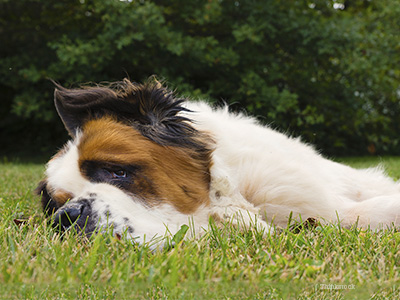Dr. Phil Zeltzman is a traveling, board-certified surgeon in Allentown, PA. His website is www.DrPhilZeltzman.com. He is the co-author of “Walk a Hound, Lose a Pound” (www.amazon.com).
Kelly Serfas, a Certified Veterinary Technician in Bethlehem, PA, contributed to this article.
 Causes of OCD in dogs
Causes of OCD in dogs
With OCD, it is believed that the blood is not efficiently circulating to the cartilage. Therefore, the cartilage in the affected joint separates from the bone and causes pain and limping.
Other factors suspected to cause OCD include:
- Rapid growth
- Trauma
- Nutrition and hormone imbalances
Genetics also plays a role since the condition is mostly seen in large and giant breed dogs. Affected dogs should be spayed or neutered.
Diagnosis of OCD in dogs
The diagnosis of OCD is based on history, age of the patient and X-rays. Ideally, X-rays should be taken under sedation, because proper position of the patient is critical. Your veterinarian will probably want to X-ray both joints because about one third of the time there is a similar problem in the opposite leg, even when a dog seems to be limping only on one leg.
Treatment of OCD in dogs
An OCD flap moves around in the joint and causes pain, similar to a pebble in your shoe. You can take pain medications or joint supplements to help with the pain or you can rest your leg, but the only thing that is truly going to help you long-term is to remove that annoying pebble.
Similarly, surgery is the best way to remove the OCD flap in dogs.
There are two ways to remove the flap: one is with traditional surgery, where the joint is opened up. The other way is to perform arthroscopy, where a camera and special instruments are placed inside the joint. In some cases, stem cell therapy may help dogs with arthritis after an OCD problem. The longer the procedure is delayed, the more arthritis will develop. Joint supplements like glucosamine and fish oil (omega-3 fatty acids) will probably be prescribed after surgery and for life to slow down further arthritis.
Postop care
Because OCD typically happens in puppies, they tend to heal quickly and may only need to rest for a month. Older dogs are a whole different story. If an OCD problem has been missed during puppyhood, the diagnosis is usually made years later. At that point, the joint may be full of arthritis, especially in the ankle. This is why routine checkups are so important.
Prognosis of OCD in dogs
Whereas the outcome is typically good to excellent in puppies, it may not be as rosy in adults. The signs, the diagnosis and the surgery are the same, but the outcome can be different because adults will logically have more arthritis than a young dog. This is the reason why any limping in a puppy should always be thoroughly investigated until a cause is found.
Prevention of OCD in dogs
Prevention is difficult in your own dog. You can, however, minimize trauma and violent exercise. You can also make sure you are feeding growing, large or giant puppy food. Don’t give calcium supplements. Prevention is aimed at improving the breed via genetic selection.
Questions to ask your veterinarian:
- Could my limping puppy have OCD?
- How can we confirm the suspicion ASAP?
- Which surgeon do you recommend to get it treated effectively?
If you have any questions or concerns, you should always visit or call your veterinarian -- they are your best resource to ensure the health and well-being of your pets.
